Everything you need to know to visit the Faroe Islands
[Updated April 2020]
This post contains affiliate links for which Expedition Wildlife may receive a commission (where applicable) at no additional cost to you.
In a word, the Faroe Islands are magical. The wild sea. A hugging breeze. Warm and hearty people. Droves of sea birds and other wildlife… Even in our damp rain gear, we loved every minute.
The Faroes were on our bucket list for a long time. They have extensive sea bird colonies, and one island is home to the largest colony of Storm Petrels in the world. But now, it’s popping up on more people’s travel radars as a must-go destination.
This being said, the number of rental cars and places to stay remains a limiting factor on the number of visitors at once. Despite the fact that the number of visitors has increased exponentially in recent years, we never felt as if places were overly crowded during our visit.
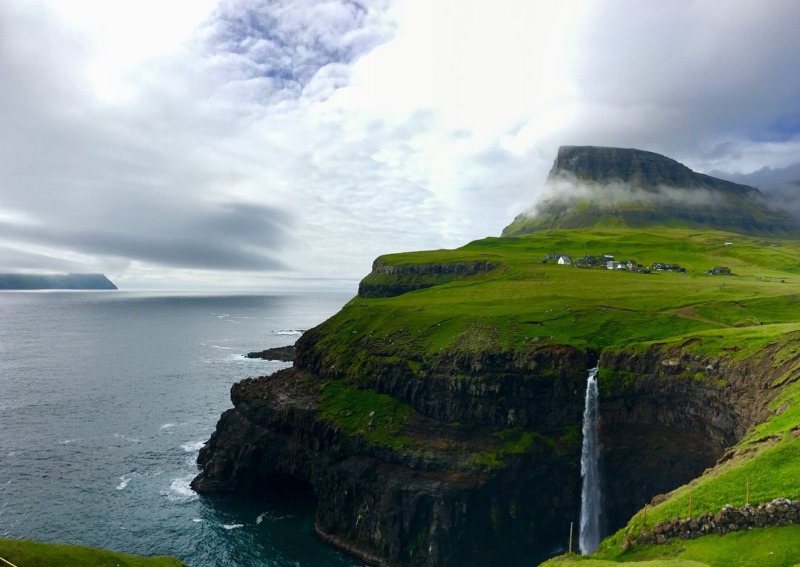
Gásadalur is a landmark destination on the island of Vágar. Photo by Christa Rolls
About the Faroe Islands
The Faroe Islands are technically and politically part of Denmark. However, they are more like their own country, isolated in the North Atlantic Ocean between Iceland and Scotland.
The Faroes have their own monetary system (though the notes are equivalent to the Dutch Kroner), language, traditions, music, and more, and their centuries-old culture stems back to the time of the Vikings.
Its placement in the North Sea makes the 18 main Faroese Islands windblown and treeless, but they aren’t without life.
Stunning greenery and flower-hewn meadows spring above dramatic cliffs that lead straight to the sea. The Faroes are home to millions of birds that breed in various locations on the islands throughout the summer.
There are also more sheep on the Faroes than there are people (hence why the Faroese Google maps was made on the backs of sheep rather than cars). Sheep are used almost solely for milk products and meat.
For comprehensive information about the Faroe Islands, check out their tourism board’s webpage. If you have any questions not found on their site, the representatives via email are incredibly helpful and friendly! They recommended to us the best way to see Mykines (pronounced ME-CHIN-ES) and Nólsoy Islands.
If you need any more encouragement to decide whether to visit the Faroe Islands, check out the awesome video we made from our trip and continue reading!
When to Visit the Faroe Islands
HIGH SEASON: MAY – AUGUST
The high season in the Faroes is summertime, typically starting around May and going into August.
Summer is when the sea birds are active and nesting, and the weather isn’t quite as unforgiving… however, don’t expect to visit in July or August and experience sunny, warm days. Expect rain and lots of wind, and plan for the temperature in summer to hover somewhere in the 60’s. This means bringing plenty of warm clothes and layers, especially rain gear.
Don’t let potentially dreary weather discourage you from getting outside and exploring, though! There are so many incredible sights to see.
Summertime boasts 22 hours of daylight, where the sun barely dips under the horizon before making itself known again.
It’s also possible to visit outside of high season, but note that some places won’t be open in wintertime and some modes of transport will be totally inoperable. Most of the sea birds will also have moved on from their breeding ground by the end of August.
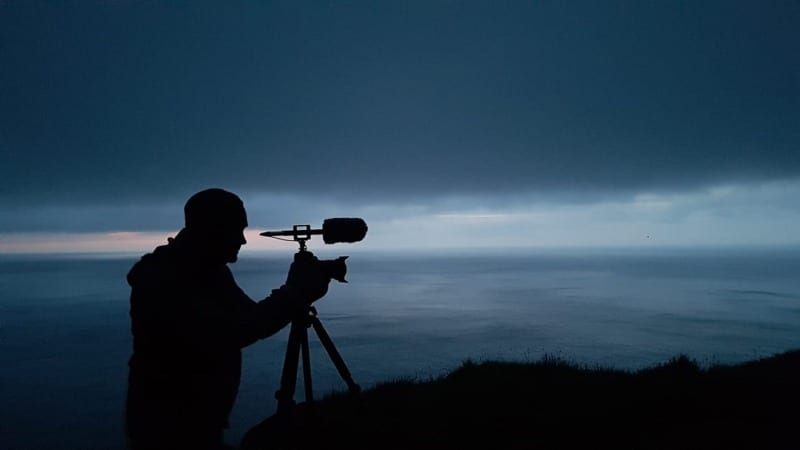
Nathan takes twilit videos of Storm Petrels on Nólsoy, the sky growing pink again around 1:30 a.m. Photo by Christa Rolls
How to get to the Faroe Islands
THE BEST WAY TO GET TO THE FAROES IS TO FLY
Vágar is the main airport on the Faroe Islands to which you will fly.
SAS and Atlantic Airways have direct flights from a selection of locations to the Faroe Islands, including from Reykjavik, Bergen, and Copenhagen.
Copenhagen via Atlantic Airways easily had the least expensive direct flights to the airport in Vágar in July.
Don’t forget to account for checked luggage when purchasing tickets, as they are typically not included in the base price.
OR, TAKE THE FERRY TO THE FAROE ISLANDS
It’s possible to take a multi-day ferry boat from Iceland or Denmark to the Faroe Islands, but get ready to be on the sea in rough waters.
If you can swing the long travel time (19 hours from Iceland and 36 hours from Denmark), you can cut your initial transportation costs at least in half.
Driving your car onto the ferry is possible – look into deals through the ferry well ahead of time. Doing this will allow you more financial leeway since renting a car can be very expensive on the Islands.
Note that the Faroese are very used to weather changes, so places will largely be understanding if your flight is delayed or temporarily canceled due to fog (this happens a lot!). They’ll also understand if other modes of public transport aren’t running, including the ferries or helicopters.
This is also why we always recommend purchasing travel insurance for your trips (see Gear Recommendations for more information).
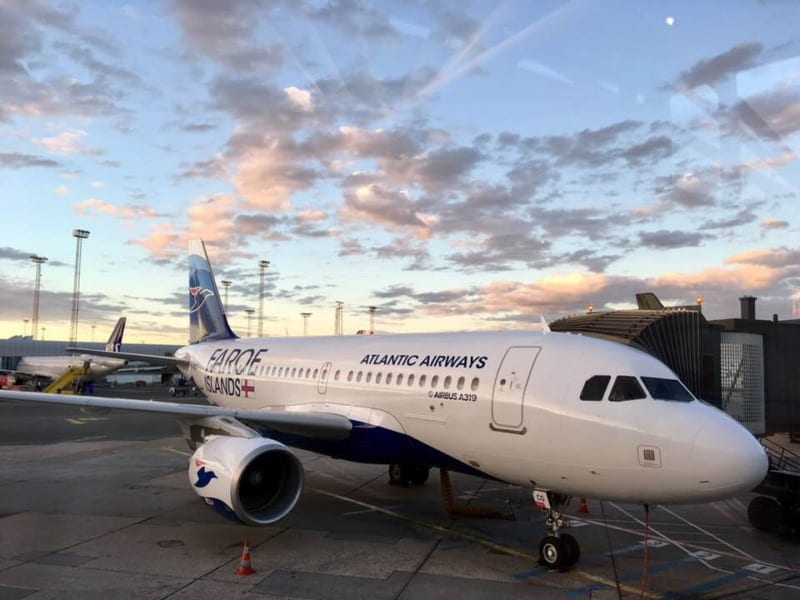
Atlantic Airways offers direct flights into Vágar from a number of locations, including Copenhagen. Photo by Christa Rolls
Getting around the Faroe Islands
THE BEST WAY TO GET AROUND THE FAROE ISLANDS IS TO DRIVE.
You’ll also need to take the ferry to get between islands.
We personally felt that driving around the Faroes was very easy.
Visit Faroe Islands has compiled a guide for driving in the Faroe Islands. Pay the greatest attention to yielding and right-of-way rules of the road.
The various modes of transportation include:
Bringing Your Own Car
As mentioned in the previous section, you can transport your car to the Islands via the ferry line. This is definitely a more cost-effective way to get around the Faroe Islands if it’s an option for you.
Renting a Car
Secure your car rental as far out as possible!
Cars for rent are limited on the islands and once they’ve run out, there isn’t a backup supply. Aim for reserving 4-5 months out, if possible.
My go-to for car rentals is to check out Rentalcars.com to see what my least expensive options are at my destination. Plus, if you download the Rakuten app for free, you’ll get between 3-10% cashback for booking with Rentalcars.com!
The big-name companies from which you can rent a car at the airport are Sixt, Avis, Budget, Europcar, and Hertz. Local outfitter 62* North arranges car rentals through Hertz, Sixt, and Europcar as well as guided and self-guided tours of the Islands.
Bilimport, Just Drive, Make Travel, Rent Your Car, and Vest Car Rent are local agencies among which you can cost compare.
If you find that prices have jumped, you have a couple of other possible car options
One, take a look at the options in downtown Tórshavn, as the prices will be a little less expensive than at the airport. You can take the bus that stops right out in front of the airport directly to the car rental shop, just let the bus driver know exactly where you are going (for approximately $14 or 90 Faroese Krona).
Two, only rent a car for a handful of days, specifically for when you want to drive around and explore other parts of the Islands.
This is what we did. We took public transport or walked to where we needed to go for a few days in lieu of getting a car.
For perspective, from the airport, you can get a direct bus that takes you into downtown Tórshavn or you can literally walk out of the airport and ten minutes later you’ll be in Sørvágur. Ten minutes further and you’ll be at the ferry dock to get to Mykines.
You can’t take a car to Mykines anyway, and we suggest spending at least one night on Mykines. So, that in itself can save you one to two days of car rental costs just by walking (or getting a taxi) 20 minutes to the ferry dock.
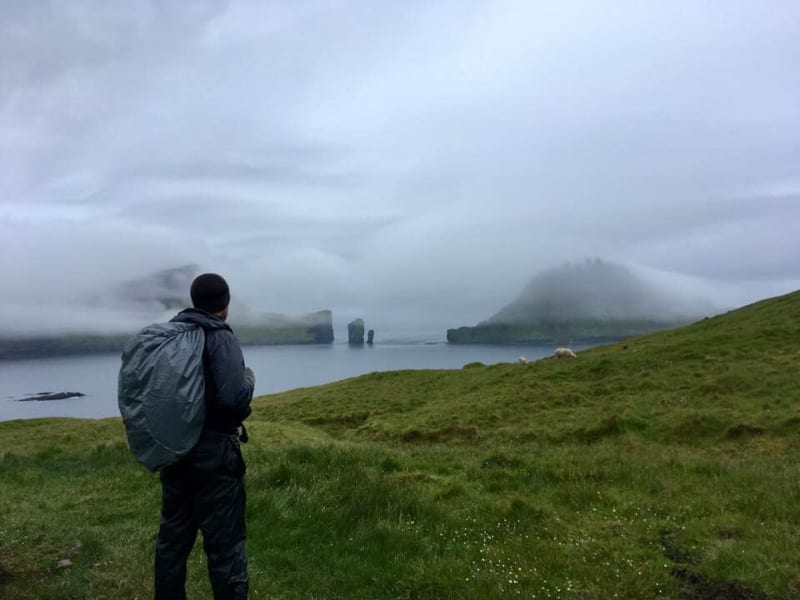
Despite not having a car the first couple days of our trip, Nathan and I hiked from Sørvágur toward Gásadalur via the overland trek (trailhead coordinates 62.091919, -7.398229). Photo by Christa Rolls
Taking Public Transportation
Public transportation is surprisingly a workable mode of transport around the Faroe Islands. Take the bus #300 or ferry around to various islands and locations, or even schedule a helicopter through Atlantic Airways to take you somewhere.
The main reason public transport isn’t ideal is that you are at the behest of the bus time schedule (which is pretty limited in some places) as well as the weather.
Bus
A reliable and easy way to get from one location to another, the bus is a good option on the Faroe Islands.
Bus stops are often not well-marked in some of the smaller villages and there tend to be multiple stops per town, even though one time is indicated on the timetable.
If the bus schedules indicate the bus will stop in Sørvágur at 10:00, for example, simply go to one of the overhanging benches with a bus symbol. It will surely be on the way soon. The travel route map for all buses (including bus numbers) and ferries is on the Strandfaraskip Landsins webpage and shown below.
You can purchase a Travel Card for getting around the island via bus or ferry at a reasonable price. If you’re considering public transport for the entirety of your trip, this is an inexpensive way to go. When booking, always note if you are traveling with a child under 15 or a student, as they receive discounted rates.
Ferry
Certain islands require a ferry or helicopter to access, such as Nólsoy, Skúvoy, and Mykines.
While most ferry tickets can be purchased online at the SSL webpage or on-site at the ferry terminal, the Mykines ferry ticket must be booked in advance directly from their webpage.
In high season, Mykines tickets sell out quickly, so be sure to book this early as well!
If you’re prone to motion sickness, even a little, make sure you bring your Dramamine or Bonine and take it at least one hour prior to departure. Or carry your preferred sea sickness aid, such as wrist bands.
The seas can get pretty rough, and the boats will usually run even if the waves are really choppy.
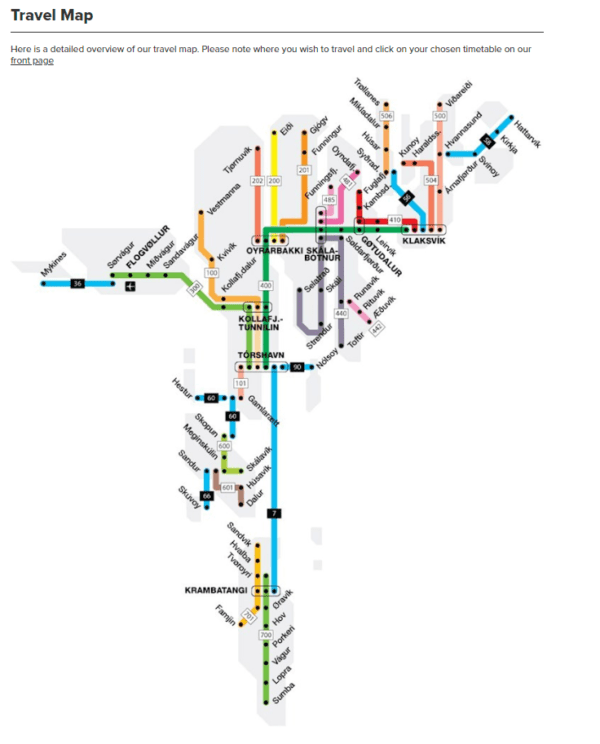
Travel Map indicating the bus and ferry routes throughout the Faroe Islands. Image by SSL.fo
Helicopter
It might sound out of your budget but helicopters are actually nearly equivalent to a bus ticket at around $20 or 125 Faroese Krona (FOK).
They are pretty booked in advance, so if the weather prevents your helo from going out, chances are you won’t make it on the next flight if you’re visiting during high season.
Note also that helicopters are subsidized by the Faroese government for residents who live on some of the more remote islands. The expectation is that visitors will utilize helicopters for one-way trips, then ferry or bus around from there.
Renting a Bike
Biking around the Faroes is a daunting task, but if you’re physically able and willing, and you have the proper gear, this is a neat way to explore.
You can hop on the bus from the airport to Tórshavn and rent a bike from Rent A Bike.fo or the Visit Faroe Islands tourism office. Either way, be sure to contact either ahead of time to reserve a bike and inquire about further rental details.
Note that bikes cannot be ridden through the tunnels, and for good reason. It is a serious safety hazard to bike or hike through these. Instead, you can strap your bike to the outside of most public buses while going between islands that require a connection tunnel.
Booking a Tour Guide
A tour guide can get you to various places on the Islands, even for just a short period of your visit. Local guides are a great way to get more local information, and you’ll be taken directly to the sights you want to see.
Keep in mind that you will have to abide by the tour’s schedule instead of doing your own thing. This option is also more expensive.
There are a handful of guides on the Islands that offer tours, such as 62 degrees North and Greengate.
An alternate, popular option is to purchase a self-guided tour through one of these companies. They book your car rental and accommodation for you and send you off with a pre-determined, self-guided itinerary.
Staying in Torshavn? Short on time? Check out these tour options!
- Visit the highlights of the northern Faroe Islands in a day.
- Experience the spectacular Vestmann Bird Cliffs.
- See the Faroe Islands in four days, including highlights such as Mykines and the northern islands!
- Go directly to Mykines from your hotel to see the incredible puffin colony.
Interested in our self-guided week-long itinerary of the Faroe Islands? Get it here!
Where to Stay During your Faroe Islands Visit
There are a handful of accommodation options in the Faroes, including hotels, bed and breakfasts, AirBnBs, and campsites.
Wild camping is prohibited on the Islands – you are required to sleep at a designated campsite with your tent or RV.
Going to designated campsites, however, reduces the cost of accommodation. Especially if you bring your own camping gear!
The main reason we chose not to camp is because of the typically rainy and windy weather often experienced on the Islands – we wanted somewhere we could dry off at the end of the day!
Make sure you begin the process of booking early, as places begin to fill up quickly as high season approaches. Some locations may offer an early-bird discount – it doesn’t hurt to ask, especially if you’re planning many months in advance!
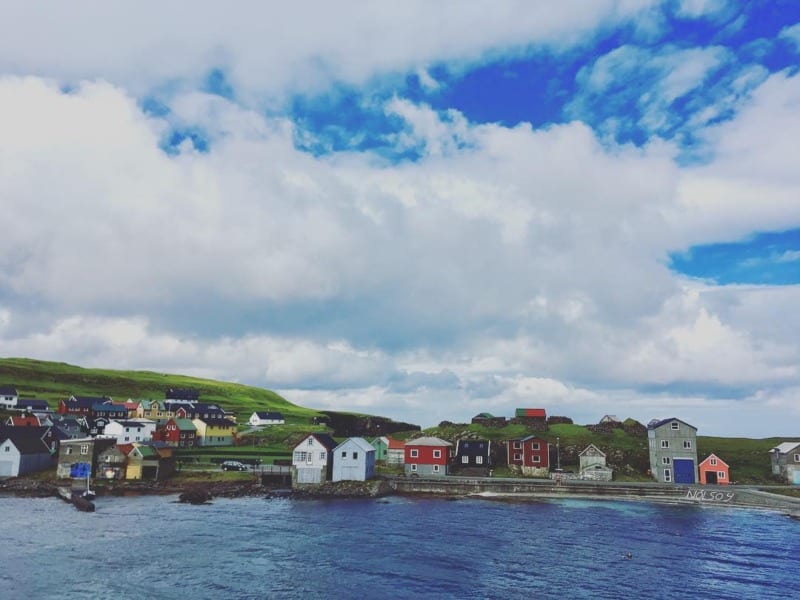
The sweet, small village of Nólsoy was the perfect place to spend a night and venture to some of the best bird cliffs on the Islands! Photo by Christa Rolls
Hotels and bed and breakfasts are great in that they often offer wonderful recommendations for things to see/do around the island.
AirBnBs tend to be much less expensive than the hotel option comparatively, and our correspondence with the hosts ahead of time yielded great travel info. They allowed us to visit places we wouldn’t have been able to stay otherwise, including Mykines!
We recommend starting with Booking.com to see what options there are as far as hotels and bed and breakfasts. Try contacting some of the locations separately to see what kind of deal they might offer you for direct booking.
Food and Water in the Faroe Islands
This region has some incredible food opportunities, including delicious fish soup, locally harvested root vegetables, fermented meats, and fresh lamb.
I was surprised to find carrot cake nearly everywhere I went, and I LOVED every bite.
While Tórshavn has a Michelin rated restaurant – KOKS – there are numerous local restaurants and cafes dotted throughout the Islands that serve delicious, local meals.
If you are looking for a local beverage, Føroyar Bjór (or Faroese Beer) and Okkara are the Islands’ brewing companies. They each have delicious beers and ciders, and both are often found in grocery stores, restaurants, cafes, and gas stations around the Islands.
I highly recommend Føroyar Bjór’s Black Sheep Dark Lager. Though it may be more difficult to find, don’t worry – Gjáarkaffi in Gjogv carries it, along with some stunning views!
Before heading out on your flight, you can also grab local beers or liquors at the Duty-Free shop once you’ve passed through security.
“PE” grocery stores were our go-to for picking up food supplies at a reasonable cost.
Water from the tap is perfectly safe (and tasty!) to drink. We stayed in a camper van on our first night, and our drinking water came from the hose system hooked up to the camper van – no issues whatsoever!
Quick note on menu items
You’ll commonly see Guillemot or Puffin on the menu.
Seabird fowling, as the harvesting is called, has been occurring on the Faroes for centuries and adopts sustainable methods to maintain population levels.
Puffins are now locally protected and are largely not hunted to allow their population numbers to bounce back. Those you see on the menu are likely from other Scandinavian countries.
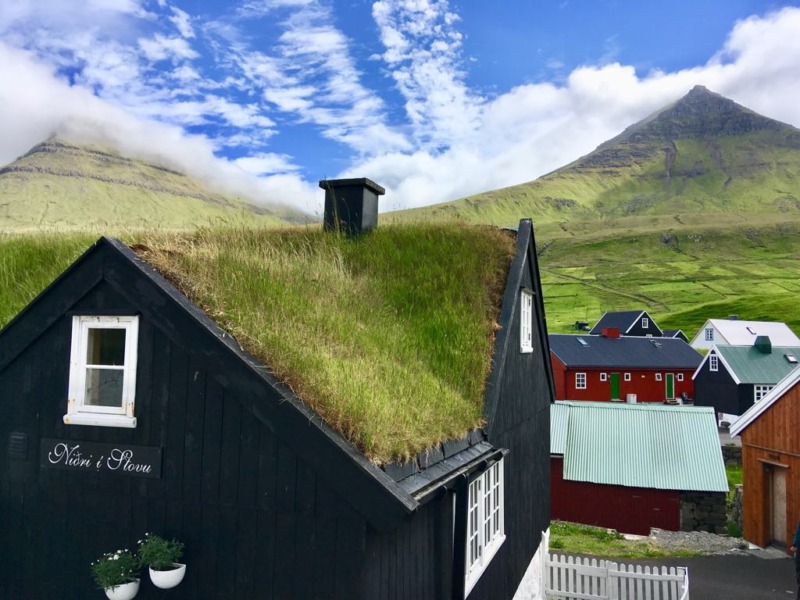
The beautiful town of Gjogv is the perfect place to stop for a brew and enjoy the views! Photo by Nathan Rolls
Cost of visiting the Faroe Islands
Our one week of travel to the Faroes for two people, flying from Copenhagen to Sørvágur in July, cost around $2,400. Note that the Faroese Krona (FOK) is equivalent to the Danish Krone (DKK), so whether you see FOK or DKK, know they are the same amount and conversion.
Most places in the Faroes will accept DKK if you have some leftover from Denmark. However, places on the mainland will likely not accept FOK.
The cost of our trip includes:
Transportation
– Flight from Copenhagen to Sørvágur via Atlantic Airways: $500.
– Car rental for three days (Budget, Tórshavn branch): $450 – We ended up taking the bus from the airport to Tórshavn to get our car rental. The airport had a limited fleet by the time we had booked our trip. Tórshavn’s rates also tend to be more forgiving than those at the airport.
– Ferry transfers (to Mykines and Nólsoy): $60 – 120 DKK, or $13 per person round trip, to ferry from Sørvágur to Mykines, and 80 DKK or $12 per person round trip from Tórshavn to Nólsoy. The Mykines transfer can ONLY be booked through the Mykines ferry site and runs from 1 May to 31 August.
– Bus transfers (to and from Tórshavn): $30 – approximately 50 DKK or $8 per person for a one-way trip.
– Subsurface Tunnel Tolls: $30 – 100 DKK or $15 per return trip. These are paid only between Vágar and Streymoy, and Leirvík to Klaksvik. When renting a car, indicate you would like the automatic toll reader, which will charge you when you checkout at the rental car facility. This saves you the hassle of having to stop at a petrol station to pay for the toll. Your bus fare will also cover this toll amount.
– Gas: $60 – Since we only had the car for a few days and it was very fuel-efficient, we only had to fill up the car once before dropoff again in Tórshavn.
Accommodation
– Accommodation for 6 nights: $620, including AirBnBs and local rentals.
Food
– Food: $350 – Primarily, we ate groceries from the local store, including ramen noodles and carrying a few days’ worth of snacks and sandwich fixings for the duration of the trip. We ate out for dinner twice (fish soup on Mykines and fresh salmon from Muntra 8, Fuglafjørður) and visited a couple of cafes for coffee or beer along our drive around the country.
Tours and Gifts
– Souvenirs: $50 – We are big on bringing a local piece of art home if we can. This trip we selected a piece of puffin artwork made out of local wool!
– Tours: $270 – We paid for two specific tours, the first on Mykines and the second on Nólsoy. Both are HIGHLY recommended!
Starting May 2019, visitors to Mykines are required to pay a fee to access the restricted area of the island. The restricted area is where practically ALL the nesting birds are and you won’t want to miss it. Their webpage indicates that “From 11 am to 5 pm the restricted area can be accessed without a guide, at all other times a guide needs to accompany visitors,” so while a guide isn’t absolutely necessary to see one of the best places on the Island, we highly recommend it.
Go with Heini at Visit Mykines for your visit ($70 for two)!
For Nólsoy, Storm Petrel tours are booked directly through the Kaffistovan on the island. A local guide will take you to the Island’s bird cliffs until the early hours of the morning – an absolute MUST DO ($200 for two).
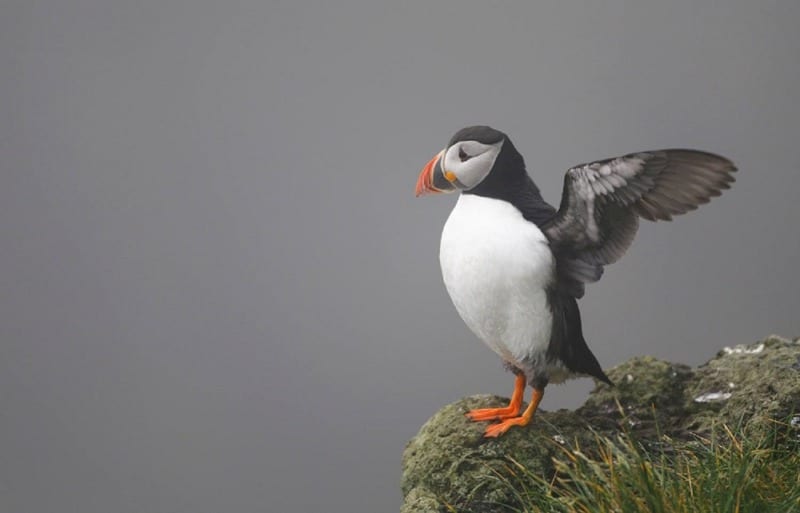
Puffins abound on Mykines island – totally worth the visit and the tour! Photo by Nathan Rolls
Gear Recommendations for the Faroe Islands
There are certain pieces of gear we absolutely couldn’t have done without on our trip, especially our rain gear, layers, camera gear, and eye masks. Here’s our checklist!
Backpacking Gear
- Deuter Lite 60+10 SL Hiking Pack with Rain Cover (her)
- Gregory Baltoro 85L Pack (him)
- Small, lightweight, collapsible day pack (for day hikes)
- Manfroto camera pack
Food and Water
- Camelback 3 L bladder (for day hikes)
- Camelback Water Bottle
Clothing and Footwear
- Vasque hiking boots
- Three pair hiking socks (SmartWool and Darn Tough)
- Reef flip flops (or other house shoes)
- Three pair Patagonia hiking underwear (originally purchased on discount at REI)
- Two hiking bras (originally purchased on discount at REI)
- One pair Columbia convertible pants
- Two moisture-wicking long sleeved shirts
- Two moisture-wicking short sleeved shirts
- Patagonia fleece (given to me by a mountain hut manager after someone left it for a month)
- Smartwool long john pants (originally purchased on discount at REI)
- REI puffy jacket
- North Face rain jacket
- Columbia Rain Pants
- Buff neck warmer
- North Face glove liners
- Prana ear warmer
Emergency and First Aid
- First Aid kit: alcohol wipes, antibacterial ointment, antidiarrheal, antihistamines, ibuprofen, Dramamine, antacid, epipen, gauze, medical tape, small round of duct tape, safety pin
- Hiking whistle (check the chest buckle on your hiking pack – some have a whistle built in)
- Travel Insurance – we recommend this for every trip you take!
Health and Hygiene
- Toiletries: wet wipes, face wipes, toilet paper, hand sanitizer, nail clippers, contacts and glasses, sunscreen, mini toothbrush, toothpaste, sunscreen lip balm, collapsible hair brush, care plus clean bio soap (biodegradable; for skin, hair, dishes, and clothes)
- Lightweight camping towel
- Sunglasses and baseball hat
Extras
- Eye mask and ear plugs (in summertime, it will be light outside practically the whole day – an eye mask can help get you to sleep if your accommodation doesn’t have blackout curtains)
- Phone charger (with standard Size C/F European plug) and battery charger pack
- Dry bag and large trash bag to line the inside of our packs (in addition to rain cover)
- Stuff sacks for organizing gear
- Bird ID book for Europe
- Binoculars
- QALO silicone ring
If you’re a birder and plan on trying to ID some of the birds you see on your trip, definitely bring along binoculars and a bird book!
Personal Items
- Cellphone with locally purchased internet package or SIM card
- Credit cards and ID/passport
Electronics
- Canon 5D Mark IV (best for videography)
- DJI Mavic 2 Pro Drone* (Fly More combo includes extra batteries, extra propellers, and a travel bag)
- GoPro Hero 7
- Microsoft Surface Go and 2 TB Hard drive (for on-the-go video and photo backup)
- Loads of extra batteries and memory card for each piece of electronics
Seriously, consider grabbing a GoPro for your adventures – it’s even waterproof!!
Note on Drone Use in the Faroe Islands
As with most locations, there are certain restrictions drone users must follow to be in compliance with local laws.
Equally as important is carefully watching how your drone impacts the wildlife around you.
The Faroe Islands are home to many thousands of sea birds and other wildlife, and these animals can be sensitive to disturbances caused by drones. Oystercatchers, in particular, aren’t fond of drones.
We warn you now, if you fly with Oystercatchers in the area and aren’t diligent about watching your drone or how the birds are reacting to it, you’re likely to lose your drone to the water after a bird collision. Also, if you’re seen harassing or injuring wildlife, you will be fined. As soon as you spot Oystercatchers in the area, bring your drone back to you!
We DO love being able to use our drone, though, so check out our favorite drones to fly and travel with.
The Mavic Air is more affordable and lightweight, however, the Mavic 2 Pro will be able to withstand those Faroese winds better! The Mavic 2 Pro also has slightly better image quality.
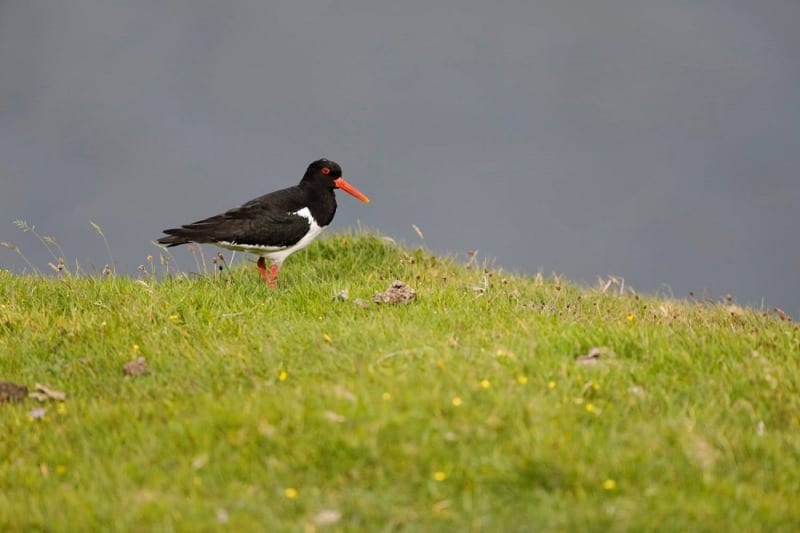
Black Oystercatchers are some of the most common birds you will see (and hear) on the Faroe Islands. Photo by Nathan Rolls
Are you so excited for your trip to the Faroe Islands?? Drop us a line if you have any questions and we hope you enjoy!
Happy travels!
Christa and Nathan
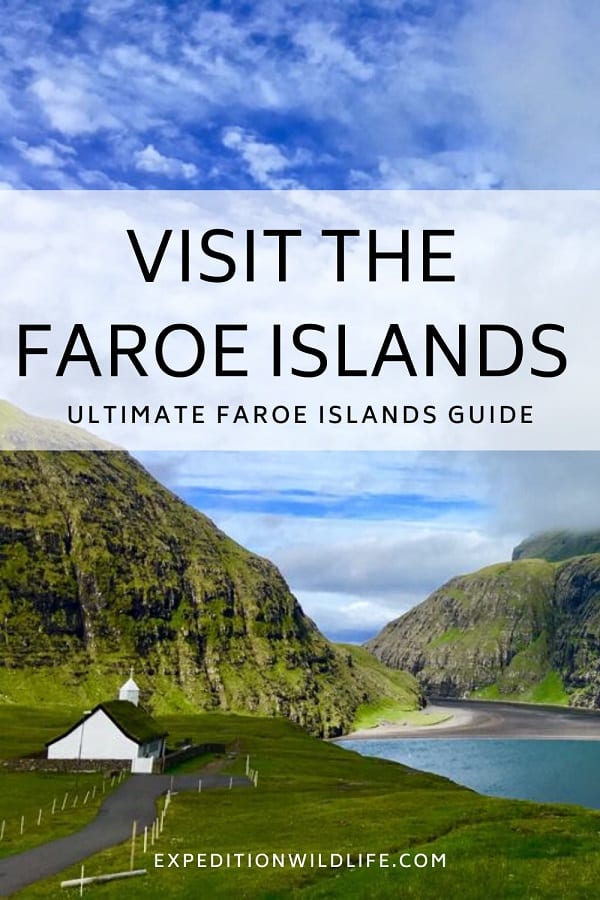

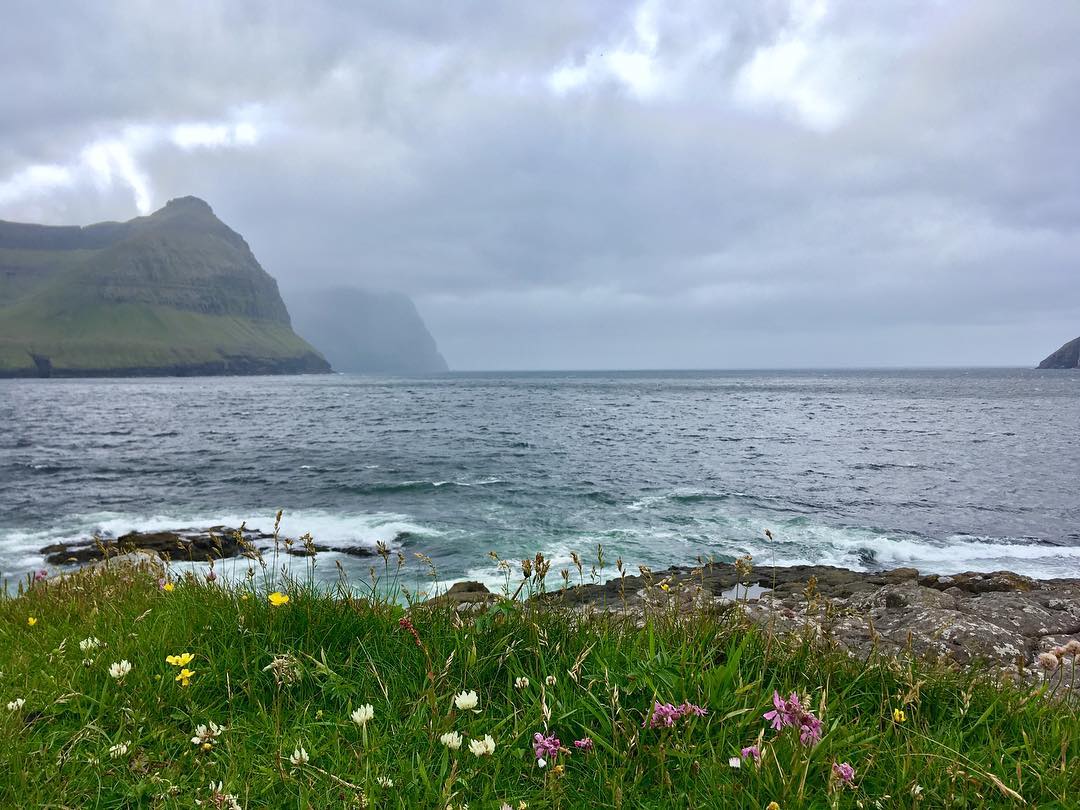



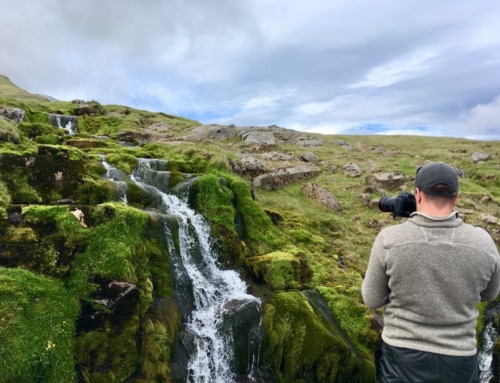
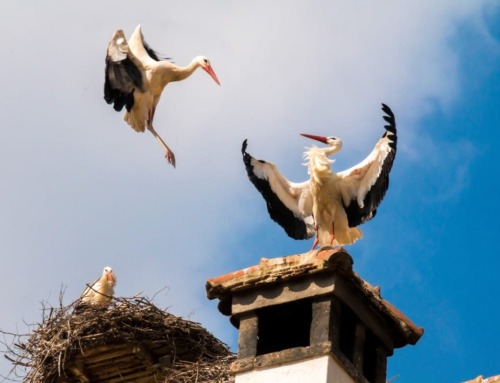


Leave A Comment